Related Research Articles

Guizotia abyssinica is an erect, stout, branched annual herb, grown for its edible oil and seed. Its cultivation originated in the Eritrean and Ethiopian highlands, and has spread to other parts of Ethiopia. Common names include noog/nug ; niger, nyger, nyjer, or niger seed ; ramtil or ramtilla; inga seed; and blackseed.
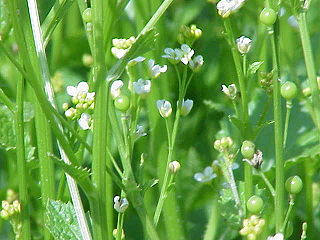
Crambe abyssinica is an annual oilseed crop of the family Brassicaceae. It is mainly cultivated due to the high levels of erucic acid that are contained in its seeds. The crambe oil is used for industrial purposes and its side products can be partly used as animal feed.

Hagenia is a monotypic genus of flowering plant with the sole species Hagenia abyssinica, native to the high-elevation Afromontane regions of central and eastern Africa. It also has a disjunct distribution in the high mountains of East Africa from Sudan and Ethiopia in the north, through Kenya, Uganda, Rwanda, Burundi, Democratic Republic of Congo, and Tanzania, to Malawi and Zambia in the south. A member of the rose family, its closest relative is the Afromontane genus Leucosidea.

The Abyssinian genet, also known as the Ethiopian genet, is a genet species native to Ethiopia, Eritrea, Somalia, Sudan, and Djibouti. It is listed as Data Deficient on the IUCN Red List. It is one of the least-known genet species.

Guizotia is a genus of African herbs in the sunflower family. They are often known as sunflecks. The species G. abyssinica is occasionally found outside of cultivation in Europe, North America and Asia.
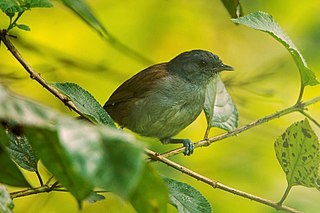
The African hill babbler is a species of bird in the family Sylviidae.
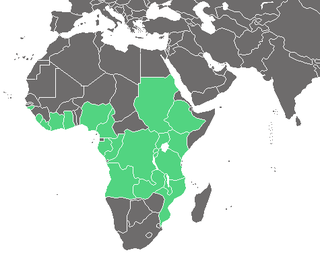
Bersama abyssinica is a species of medium-sized evergreen tree in the Francoaceae family. The leaves are pinnately divided with a strongly winged rachis. The inflorescence is a spike.

Oxytenanthera is a genus of African bamboo. Bamboos are members of the grass family Poaceae.
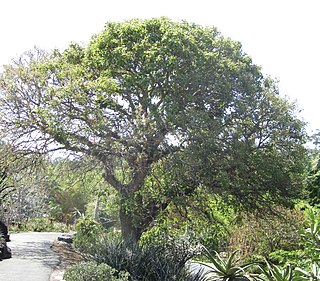
Erythrina abyssinica is a tree species of the genus Erythrina belonging to the plant family of the Fabaceae described by Augustin Pyramus de Candolle in 1825. This leguminous tree species is native to East Africa, Eastern DRC and southern Africa. In Zimbabwe its range overlaps with the similar Erythrina latissima.

Vanessa abyssinica, the Abyssinian admiral, is a butterfly in the family Nymphalidae. It is found in Ethiopia, Kenya, Tanzania, Uganda, Rwanda and the Democratic Republic of the Congo. The habitat consists of montane forests.
Diospyros abyssinica is a tree species in the family Ebenaceae which is native to Sub-Saharan Africa.
Harrisonia abyssinica is a species of shrub or small tree in the genus Harrisonia, family Rutaceae. Native to tropical Africa, its habitat is usually in transitional zones between deciduous woodlands and evergreen forest.

Vachellia abyssinica, the flat top acacia, is a tree up to 16 m tall.

Strandiata is a genus of longhorn beetles of the subfamily Lamiinae, containing the following species:
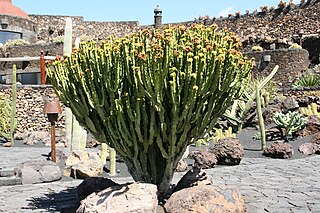
Euphorbia abyssinica, commonly known as the desert candle or candelabra spurge, is a species of plant in the family Euphorbiaceae. E. abyssinica is endemic to Ethiopia, Somalia, Sudan and Eritrea. It was first described in 1791, by the German botanist Johann Friedrich Gmelin. In its native habitat, it can grow up to 10 m (33 ft) tall. The woody stem is used for firewood and as timber in roofing, furniture and other items, and the sap is used in traditional medicine. It is also cultivated as an ornamental house plant.
Strandiata monikae is a species of beetle in the family Cerambycidae. It was described by Adlbauer in 2008. It is known from Ethiopia.

Strandiata renominata is a species of beetle in the family Cerambycidae, and the type species of its genus. It was described by Vitali F. and Vitali C. in 2012. It is known to be from Ethiopia.

Hedbergia is a monotypic genus of flowering plants, initially classified in Scrophulariaceae, and now within the broomrape family Orobanchaceae. It contains a unique species, Hedbergia abyssinica. It is an afromontane genus, widespread in grasslands and scrubs of the mountains of tropical Africa, and known from Ethiopia, Zaire, Uganda, Kenya, Tanzania, Malawi, Nigeria, and Cameroons.

Digitaria abyssinica, the East African couchgrass, is a species of flowering plant in the family Poaceae. It is native to Sub‑Saharan Africa, Madagascar, many of the Indian Ocean islands, the Arabian Peninsula, Sri Lanka, Peninsular Malaysia, Vietnam, New Guinea, and Queensland in Australia, and it has been introduced to scattered locations in Central America and northern South America, and to Saint Helena. Although it is a livestock forage, albeit a low‑quality one, it is generally considered a noxious weed.
References
- ↑ BioLib.cz - Strandiata abyssinica. Retrieved on 8 September 2014.